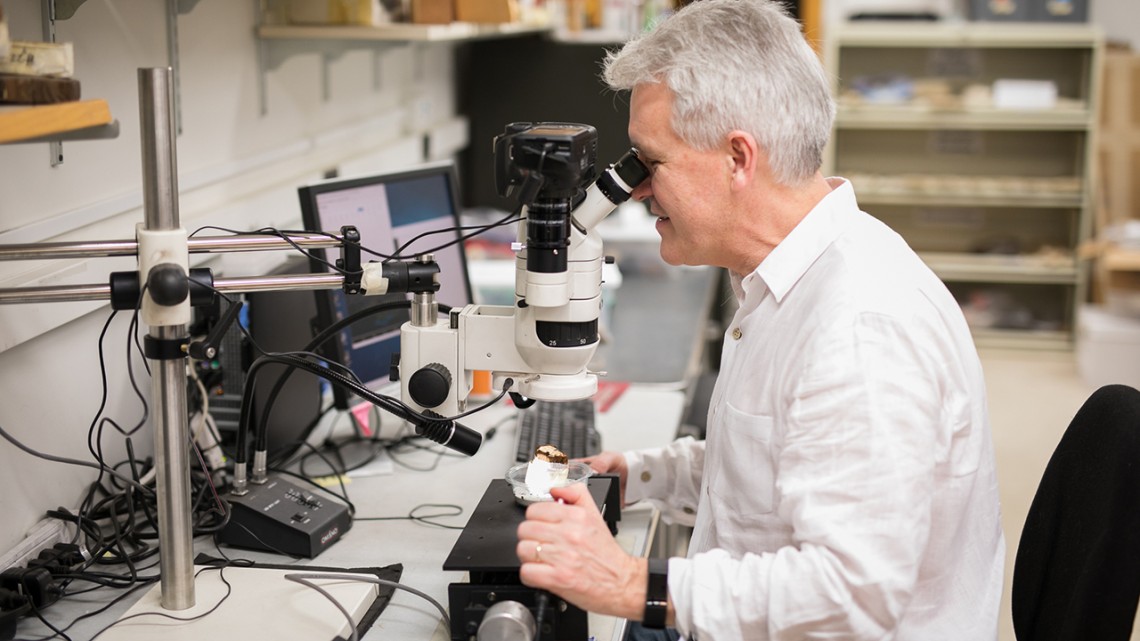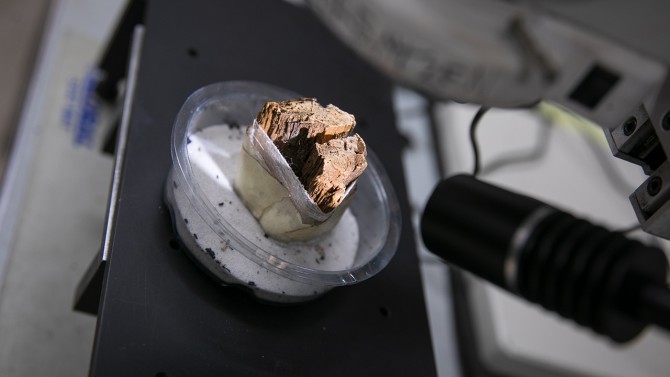
Sturt Manning, the Goldwin Smith Professor of Classical Archaeology, at work in the Cornell Tree-Ring Laboratory.
New study upends timeline of Iroquoian history
By Linda B. Glaser
New research by an international team raises questions about the timing and nature of early interactions between indigenous people and Europeans in North America.
The European side of first contact with indigenous people and settlement in northeast North America is well known from European sources. Until now it’s been assumed that the finds of dated European artifacts provide a timeline for the indigenous peoples and settlements of this period as well. New research suggests this may be a mistake in cases where there was not direct and intensive exchange.
Radiocarbon dating and tree-ring evidence shows that three major indigenous sites in Ontario, Canada, conventionally dated 1450-1550 are in fact 50-100 years more recent. This dates the sites to the worst period of the Little Ice Age, around 1600.
“This seems extraordinary: Given this was only 400 years ago, how can we have been wrong by as much as 25 percent?” said first author Sturt Manning, the Goldwin Smith Professor of Classical Archaeology, chair of the Department of Classics and director of the Cornell Tree-Ring Laboratory.
Manning is lead author of “Radiocarbon Re-dating of Contact-era Iroquoian History in Northeastern North America,” published Dec. 7 in Science Advances. Other Cornell authors include Cornell Tree-Ring Laboratory senior researcher Carol Griggs ’77, Ph.D. ’06, and doctoral student Samantha Sanft. The paper represents the first major findings of the “Dating Iroquoia” project, a National Science Foundation-funded effort led by Manning and co-director Jennifer Birch (University of Georgia).
Previously, dates in the early contact period were based on the absence – and then presence – of types of glass beads and other European trade goods in excavated sites, along with shifts in material culture, such as changes in ceramic designs. Dates were assigned according to “time transgression,” the assumption that when European goods are found in one place with a confirmed date associated with them, that same date can be used for other places where those trade goods are found.
“But goods don’t get distributed evenly within societies or across distances,” said Manning. “This is a vast area with complex local societies and economies, so the concept that everybody gets the same thing necessarily all at once is a bit ludicrous in retrospect.”
The team’s chronological findings dramatically rewrite how history has been understood in the region. The period of first European contact, rather than following major changes in Iroquoian society, can now be seen to coincide with those changes. According to Birch, an expert on Iroquoian societies, “Our work has shown that, at least for some communities, contact-era transformations happened much later and much more rapidly than previously assumed.”
“Of course, we’ve dated only one site sequence, and there are many more,” Manning said. “What this paper really shows is we now need to reassess all those site sequences where there’s not a clear historical link or association.”
The researchers first examined the Warminster site in Canada, believed to be visited by French explorer Samuel de Champlain in 1615. Using radiocarbon isotope and dendrochronological (tree ring) dating, combined with a mathematical technique, determined the indigenous settlement at the location to date from between 1585 and 1624, which corresponded with Champlain’s visit. Archaeological evidence and provided confirmation of the accuracy of their techniques.
The team then assessed a series of well-known, high profile settlements, Draper-Spang-Mantle. In the 16th century, Iroquoian societies lived in village communities for approximately 10 to 50 years; once the local resources were exhausted, the community relocated the village. Archaeological evidence indicates that these three villages were occupied in sequence by the same ancestral Huron-Wendat community. Mantle, the latest site in the sequence, was shown to date to between 1599 and 1614, partly contemporaneously with Warminster.
Co-authors on the paper are Megan A. Conger and Carla S. Hadden, University of Georgia; Michael W. Dee, University of Groningen, the Netherlands; Alan G. Hogg, University of Waikato, New Zealand; Christopher Bronk Ramsey, Oxford University, England; and Peter Steier and Eva M. Wild, University of Vienna, Austria.
The research was supported by a grant from the NSF.
Linda B. Glaser is a staff writer for the College of Arts and Sciences.
Media Contact
Get Cornell news delivered right to your inbox.
Subscribe

